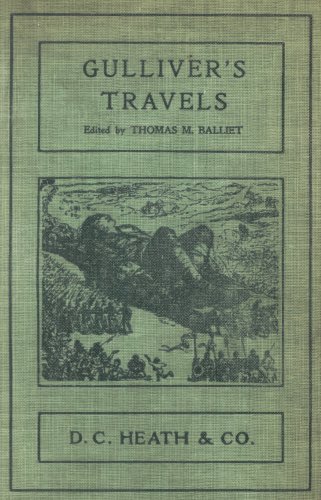Continuing with my investigation of classic stories I’ve heard about all of my life and have become curious about the originals, I’ve recently finished reading  Gulliver’s Travels. Every pop-culture version of this work I have ever seen describes Gulliver among the Lulliputians. But this adventure is only one part of four. Gulliver also travels to Brobdingnag, where he encounters a race of giants (the exact reverse of Lilliput); the flying island of Laputa, which hovers over and rules the island of Balnibarbi, with its capital city of Lagado where totally useless research is conducted; Luggnagg, with a race of immortals called struldburgs; the island of Glubbdubdrib; and finally to the land of the Houyhnhnms, populated by an equine race who is being served by humanoid savages called Yahoos.
Gulliver’s Travels. Every pop-culture version of this work I have ever seen describes Gulliver among the Lulliputians. But this adventure is only one part of four. Gulliver also travels to Brobdingnag, where he encounters a race of giants (the exact reverse of Lilliput); the flying island of Laputa, which hovers over and rules the island of Balnibarbi, with its capital city of Lagado where totally useless research is conducted; Luggnagg, with a race of immortals called struldburgs; the island of Glubbdubdrib; and finally to the land of the Houyhnhnms, populated by an equine race who is being served by humanoid savages called Yahoos.
Most of us have grown up thinking of Gulliver’s Travels as a children’s book. But actually it is a somewhat crude political and social satire. For example, Glubbdubdrib is inhabited by magicians who can conjure up the dead, so Gulliver is thus able to converse with many historical figures. Also, Gulliver comes to identify with the horse-like Houyhnhnms, who seem to have transcended the human vices, and decides to spend the rest of his life with them. Except the Houyhnhnms decide he is too much like a Yahoo and must leave for the good of their civilization. When he eventually returns home, Gulliver experiences a revulsion to living among his fellow “Yahoos” (including his own family) and spends much of his time in the stables.
Not quite what is portrayed in pop culture.
A more detailed review of Gulliver’s Travels is at https://thinkerviews.com/books/gullivers-travels-by-jonathan-swift-book-review/. The photo, an edition published in 1900, came from that site.
